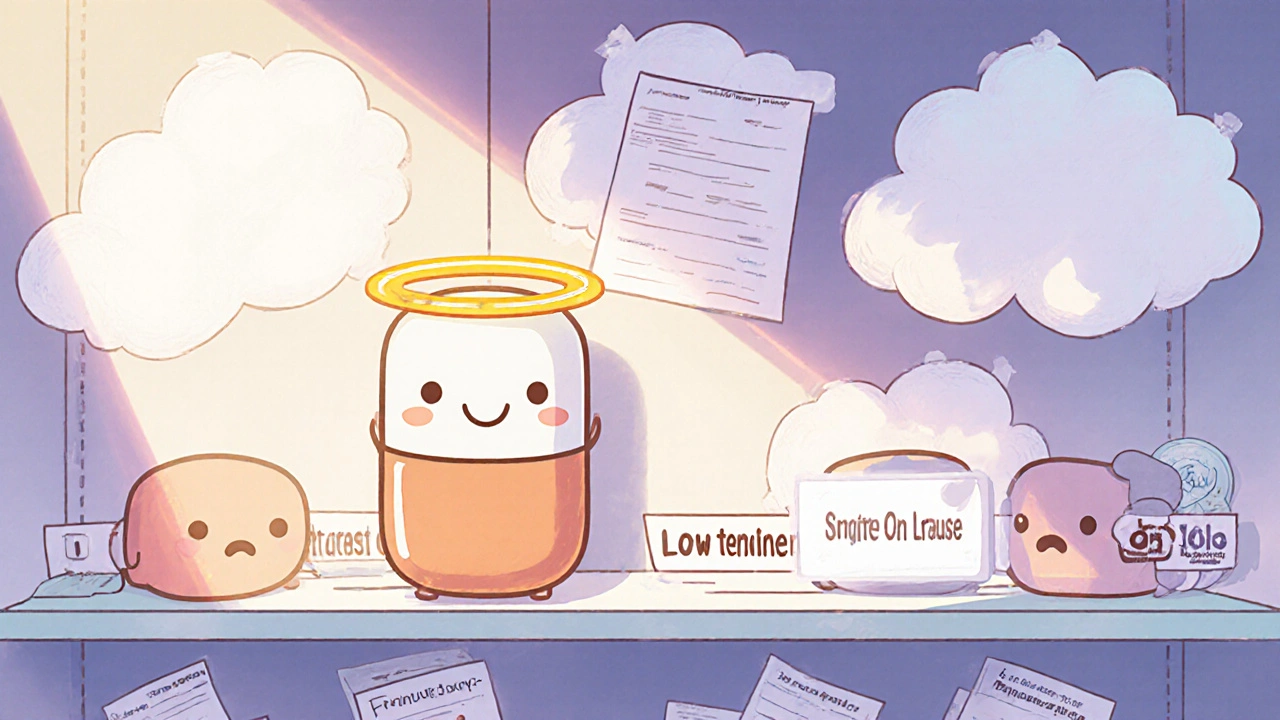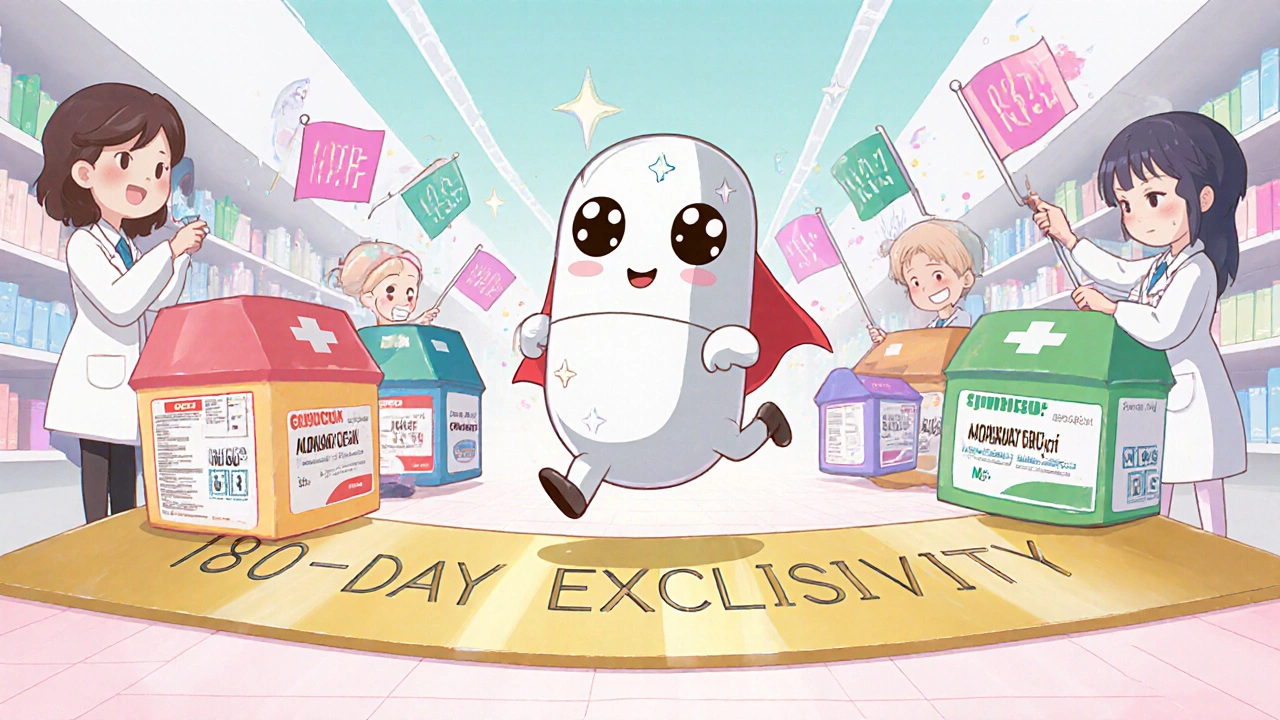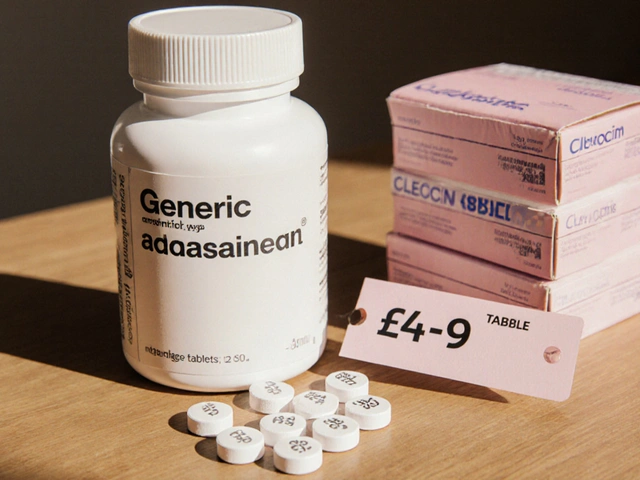When a brand-name drug loses its patent, the race to be the first generic version on the market isn’t just about speed-it’s about locking in a dominant share of billions in revenue. The first company to file a generic version and win approval doesn’t just get a head start. It gets a multi-year edge that competitors struggle to overcome, even when their product is identical in every way.
Why Being First Matters More Than You Think
The U.S. generic drug market isn’t a free-for-all. It’s structured by the Hatch-Waxman Act of 1984, which created a legal pathway for generics to enter the market without re-proving safety and efficacy. But here’s the twist: the first company to challenge a brand drug’s patent gets 180 days of exclusive rights to sell its generic version. That’s not just a bonus-it’s the entire game.During those 180 days, no other generic can legally enter. That means the first mover captures nearly the entire market. And even after that window closes, the advantage doesn’t vanish. Prescribers, pharmacies, and patients get used to the first generic. Switching costs are real. Pharmacists stock one version per drug to cut inventory costs. Doctors write prescriptions for the name they know. Patients refill the same pill they’ve been taking for months. All of that creates a kind of inertia that lasts years.
Studies show the first generic often holds 70-80% of the market during its exclusivity period. After the second generic arrives, that drops to 50-60%. By the time five or more generics flood the market, the first mover still holds 30-40%-while later entrants fight over scraps. That’s not luck. That’s system design.
The Real Economic Power of Being First
Many assume generics are all the same price. They’re not. The first generic can charge more than later entrants-even though the active ingredient is identical. Why? Because pharmacies and insurers have already locked in contracts with the first brand. The first mover gets to ride the wave of brand-name pricing before the market collapses into a race to the bottom.McKinsey found that first-movers in specialty drugs-like injectables or treatments for rare conditions-can capture up to 13 percentage points more market share than later entrants. In primary care drugs, the gap is smaller, but still meaningful. For a $500 million brand drug, that’s tens of millions in extra revenue.
And it’s not just about volume. The first generic often gets preferred placement on formularies. Insurance companies favor the one that’s been on the market longest because it’s proven stable. Hospitals build their purchasing systems around it. Even if another generic is 10% cheaper, switching means retraining staff, updating systems, and risking errors. No one wants that headache.

What Can Kill the First-Mover Advantage
The biggest threat isn’t another generic. It’s the brand company itself.Brand manufacturers can launch an “Authorized Generic”-a version of their own drug, sold under a generic label, often at the same price as the first generic. This happens during the 180-day exclusivity window. The result? Instead of a duopoly, you get a three-way battle: brand, first generic, and authorized generic. The FTC found this cuts first-filer revenue by 4-8% at retail and 7-14% at wholesale.
Some first-movers never recover. If the brand drops its price to match the generic, patients stick with the name they trust. And if the authorized generic is sold by the same distributor as the brand, pharmacies have no reason to switch. The first generic gets squeezed from both sides.
Another risk? Timing. If the second generic arrives within a year, the first mover’s edge evaporates. But if the gap is three years or more, the first mover becomes the default choice. The longer the gap, the more entrenched the advantage.
Who Wins and Who Loses
Not all first-movers are equal. Big pharmaceutical companies with global supply chains, regulatory expertise, and strong relationships with distributors win more often. They can afford the multi-million-dollar investments needed to file a complex patent challenge, build manufacturing capacity, and pass FDA inspections.Smaller companies? They often lose. Even if they’re first to file, they may lack the capacity to scale production fast enough. Or they don’t have the legal team to fight off patent extensions. Or they’re too reliant on a single API supplier and get caught in a shortage.
Domestic manufacturers have an edge, too. Data from the NIH shows U.S.-based first generics achieve 22% higher market saturation than overseas ones. Why? Faster shipping, fewer regulatory delays, and better communication with U.S. pharmacies and insurers.
And therapeutic area matters. In injectables, inhalers, or complex formulations, there are fewer players. That means less competition after the exclusivity period. First-mover advantage in these areas can be 15-20 percentage points higher than for simple oral pills.

How the Game Is Changing
The FDA’s 2022 GDUFA III rules aim to speed up generic reviews. That sounds good-but it’s a double-edged sword. Faster reviews mean more generics enter sooner. That could shrink the window of dominance.But here’s the twist: the rules also raise the bar. Complex generics now require more data, more testing, more documentation. That favors big players who can afford the cost. Smaller firms may find it harder to compete, even if they’re first to file.
Meanwhile, the FTC is cracking down on “pay-for-delay” deals-where brand companies pay generics to delay entry. In 2023, enforcement actions increased. That’s pushing first generics to market faster, by 6-9 months on average. More launches. More pressure. More winners and losers.
And now, complex generics are the new gold rush. Inhalers, nasal sprays, eye drops-these aren’t easy to copy. Few companies can do it. That means fewer challengers. That means bigger margins. That means the first mover has a better shot at holding on.
What Happens After the Rush?
Even after the dust settles, the first mover doesn’t disappear. It becomes the standard. It’s the one pharmacists automatically substitute. The one doctors default to. The one patients ask for.That’s the real power of being first. It’s not just about the 180 days. It’s about becoming the name people remember. The one they trust. The one they don’t question.
By the time a third or fourth generic enters, the market is already split. The first mover holds 30-40%. The second holds 15-20%. The rest fight over the remaining 40%. And the cycle repeats with every new patent expiration.
The first-mover advantage in generics isn’t about being the cheapest. It’s about being the most familiar. The most reliable. The most convenient.
And in healthcare, that’s worth more than money. It’s worth loyalty.







gent wood
November 15, 2025This is wild when you think about it. The first generic doesn't even need to be better-it just needs to be first. It's like winning the lottery with a patent lawsuit. I never realized how much of healthcare is just inertia and branding, not quality.